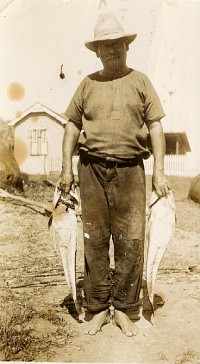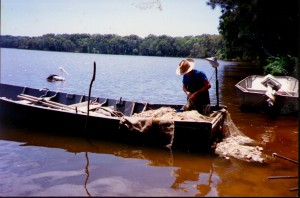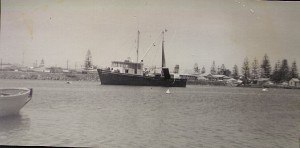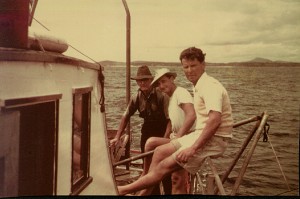
 |

Ray Black Interviewee: Ray Black, born 1928 Interviewer: Port of Yamba Historical Society membersDate of Interview: 1 May, 1992 Transcription: Marea Buist, 2001 |
Tell us about the early days of the fishing industry.
The start of the fishing industry way back around at the turn of the century is very far removed from what the fishing industry is today. Principally in method I mean although there were certainly more fish to catch in those days. The early days were very hard as most of us can remember back then back into to early 20s and 30s but in those days fisherman who plied their trade used oars, sail and they used the wind and the tide to advantage because there were no power boats. So when you envisage fishermen going to work rowing or sailing sometimes much as 12 miles away from where they lived or where they dispatched their fish and had to get back again all in a night or days work then we realise what a big job it was. Marketing in those days was very hard because we didn't have modern transport. As we are all very well aware and even I recall the days in the 30s when the North Coast Steamers use to take the fish from here to Sydney. in those days there were two boats a week and where we had small crates and containers to carry a lot of fish today we had big containers of 5 and 6 fish baskets capacity.
 |
When you
look at the big trawlers that are now tired up here in the Port of Yamba
and also over at Iluka it is hard to visualize that that industry started
in 1948 by a little 25ft boat, hand pulling a trawler net out on the south
beach. They were the first prawns caught out here in the ocean. Fisherman
knew that prawns went to sea but they did not know how to catch them,
they didn't know where to catch them, they didn't know where the grounds
were or where the open country was, where there were no rocks and reefs
and so on so that they could catch these prawns, whether it was night
time or day time. I well recall these mass migrations of prawns down this
river in the 30s. You know where the trawlers are tied up now on the inside
of the of what we use to call Pegus's Bay well at one time that was an
open bay right down to the Angourie turn off.
It was all ribbon weed growing
all the way down there except down there in the corner opposite the Angourie
Road there was a little hole no bigger than ½ an acre probably
¼ acre would have covered it. These prawns use to come down along
where the Tavern is and the Blue Dolphin Caravan Park and follow that
shore all the way down as it was all unrestricted because it was all an
open shoreline through there. There were no shallow water or sandspits
like there is today as that was all deep water and they would of course
find themselves right down in this bay as far as the Angourie turn off.
Arthur Pegus was the first cousin of my father they lived where Pegus
Motel is and that is how the Pegus Motel got its name from the Pegus dwelling
that was there. They use to haul a small mesh net out of that little hole
and use to get 20 baskets of these school prawns. If you didn't get them
at that first low tide then the next time they would go again. I remember
we use to be there as kids at 7,8,9 years old helping and being in the
road and doing everything else. They use to sell the prawns for sixpence
a quart pint measure so we use to get allotted a one pint measure for
our labours and I thought that was pretty rough as I could have eaten
as I could have eaten two quarts let alone 1 pint. However everyone was
on low wages those days including us kids.

So that is the early days in prawning and in 1948 the first prawns were caught off Yamba and apart from one sample caught off Evans Head they were the first prawns caught from the ocean.
 |
Who owned the boat?
Jack Ebeling, a man who with I worked and who lived here at Yamba for many years. These prawns were brought around into the corner of the bay where the Big Oyster is and we use to have 200 gallon galvanized tanks sitting over a big wood fire and we use boil the prawns there. Of course it was mainly a summertime exercise and of course there would be a lot of people in Yamba. The people use to flock down to have a look at these prawns and also spot them and it was very hard to do your work and to keep your eye on the people taking handfuls of prawns off the trays as they were all spread out you know. They were very big prawns in comparison to what prawns are today because naturally they were allowed to grow to their full capacity whereas today are pulled at all sizes. In those days we could not sell them. There were 13 Chinese restaurants if my memory serves me correctly in Sydney in 1948 and we couldn't get rid of these marvelously large school prawns which constitutes about 10% of what the production of prawns is today and we can't get enough today. So that's how it was in the infancy of the first prawning.
You couldn't sell them because there wasn't the demand?
There was no demand, it just wasn't there. It is remarkable what the new migrants to Australia did for seafoods. When I was working the ocean prawning the target product were prawns everything else octopus, squid we use to keep a few fish but only the prime ones but the prawns were the target. Now they make money out of squid, octopus, trawled whiting, there is nothing that goes back into the ocean everything is money. These bi-products more than pay their expenses which make the prawns complete profit. And of course if you have a look at the trawlers today, which you have you, can see that the massive production from that amount of boats comes about. For example I haven't got the figures off the top of my head for prawn production this year but the year before last there was out of the river alone there was 650,000 kilograms prawns taken without the ocean so production was very high. From that production just as a side thing the total revenue enjoyed by the Clarence River Fishermen's Co-operative from total revenue raised through fishing trawler sales was 17.1 million dollars. Now that is money which has come back into the Lower River or the Clarence River District because it was about 1.2 million dollars paid in wages just connected to people in the two cooperatives in Iluka and Maclean.
 |
Then you had the ancillary people like transport of the product you have people taking prawns all over NSW from here plus maintenance and that's without maintenance and expenditure that the prawn trawlers themselves generate. So the fishing and prawning industry is a big industry. If you would like to put it into everything it would be something like twenty million dollars per annum.
This would be the major industry? Do you think sugar cane would be greater?
I don't know the turn over of cane but I couldn't say but it is a big industry and over 400 people employed, with fisherman and staff. So it is well worth keeping. One of the biggest things that worry us is perhaps civilized progress or rather civilized expansion because in some cases it isn't progress but going backwards. Development yes which is taking over the wetlands that generate the food for the table life of marine life which is necessary to keep the marine life going right from the smallest to the largest fish. The future of the fishing industry I think is good. We are now in a situation that we are looking at the future because we realise that as we are going now if everybody doesn't put their shoulder to the wheel and finds means and ways of protecting it then there will be very little for anybody, whether it be professional or amateurs and also the continued employment of the people concerned. It also spins off to the tourist industry because you know that if you go to the Gold Coast. For example. We have been going through Queensland right back through the early 1950s. In those days you could see amateur fisherman fishing anywhere from Southport along the Nerang through to Brisbane up through Bribie Passage, to Mooloolaba and Caloundra where today there is just nothing there to be caught because development in some respect has created a marine desert by destroying the food life that is needed to generate such a marine... So we all have to be on guard and do what we can to promote this industry and keep it viable because not only is it good for the workers but it is very nice to eat.
 |
The wetlands are at particular risk, aren't they?
They are. Micalo Island project is probably the biggest tragedy. Apart from the red spot disease that reared its ugly head in 1975 and although the biologists talk about acid soils and the cane foliades breaking down oxygen levels in the water they really don't know. I think the original use of organo chloride chemicals was the biggest factor in red spot disease because while they were using it. One of the worst was the potato farmers on the Dorrigo. They used organo chlorines in big lots very often. For example I had one sample I had analyzed had 9 different chemicals in the soil. Five out of the nine were organo chlorine's that no ones how long it will take for them to break down, they could just go to infinitum. Since everybody has become aware that such things as protection for our natural wealth particularly as organo chlorines have been banned. Things are improving, we are not getting as much of that degradation in the fish stocks like we use to.
Was there red spot last year?
Yes, but each year it is getting less and less. For example. Grafton sewerage in the early days was just a cesspool that poured into the river firstly after one primary treatment. They have had to clean up their act on that one but you know I don't know how we are going to survive without chemicals, everybody uses them and it is part of our lifestyle today but they must keep finding safer ones. Chemicals that is a killer for one but not of another.
 |
Do you think there are enough studies being done on these?
No, never is. To give you an example of the tardism of NSW Governments both sides of the fence whether Conservative or Labor. Now when the original red spot we started to put pressure on the Government to do something about it. Queensland biologists were working on it up there because originally it started in Bundaberg in the Burnett River. That is an extensive cane growing area and so Queensland were doing studies, and so the NSW Government said well we won't duplicate their work it is a waste of money, we will take their findings as being as a disease there was similar to here. So the biologists in Queensland after a number of years came up with the result that a micro organism called aqualarum... .I just can't think of it for the minute and so we in this state accepted that as being the reason for this problem. Now when it didn't abate we put further pressure on the Government and they did allocate money for two biologists to work here and they worked here from on the Richmond and on the Tweed and we gave them a lot of support here. We picked up samples and worked with them in the swamps and so forth looking at water and soil samples. So after taking Queensland biologists as gospel they couldn't find vibrio aqualarum. Here, it wasn't in the fish here so there was eight years wasted.
Do fisherman in any way or groups support financially any of the research?
Yes. Each fisherman in Australia pays $200 per year. His licence fee includes $200 surcharge to go into biological investigation and research. So we are not only doing our part manually but also through our pockets.
Considering the amount of licensed fisherman that is a considerable amount?
Well yes, you are probably be looking at 5000 fishermen in the State maybe more.
Do you think there is any future for these prawn farms? Do you think anything will ever come of it?
That's an interesting question because yes. If on a minor scale they are successful if they are run as a family unit. If you look at the Prawn Farm on Micalo Island the one that was sold off to the Japanese, now they had eleven ponds there working. They had 7 or 8 staff all up and yet they were only producing in twelve months the amount of prawns equal to two trawlers. So you can imagine the costs of running a big property like that with 7 or 8 staff as opposed to two trawlers and 4 men. So if you look at it from the point of view of a family project with no wages being paid, yes they are successful but as far as production is concerned on a big scale is concerned no. They are just a good little family business.
We read about them over at Taiwan or somewhere like that they seem to be successful?
Well they have very big families and their wage structure would be minimal. What it would cost in wages here alone you would be looking at $800 to $1000 a week here just for two men but if you multiply that by 52 weeks in China or Taiwan you could buy your prawn farms and stock it up for that.
Stocking them is quite costly, isn't it?
Well one time in the early days they were taking all the prawns from a couple of trawlers and keeping them alive and were filling their ponds with these. But that was with our school prawns but they were a failure. The only success was with the Asian prawns called a monodon, which is halfway between a good schoolie and a King Prawn. I don't know whether you have tried them but they are not a nice flavoured prawn like the natural prawn.
 |
Do you feel that there are too many trawlers working the river?
Well every project has a limit, everything has a capacity and once you go beyond that of course it will start to fail and that is one of the reasons why fishermen are restricting licenses and conservation of stock. But an interesting sideline, many people come out with the same question and get quite upset and say that we are denuding the river and degrading it and doing all this sort of thing., Taking the weeds from the bottom of the river we can't trawl well if there is weed in the bottom of the river because you just fill your nets up with and you must have just clean sand or mud but it is mostly sand in the river. The only prawns caught in the river trawling are after a fresh when river turns coloured and brings the prawns down. Now it is amazing how many hundreds of thousands of kilograms of prawns lay above Grafton Bridge right through to up to the Nymboida River and in the dry time that is where they are as far up there. Well you would think that surprising, as they are mainly a salt-water thing that you catch in the ocean. When we get the freshes and floods it brings them down right to the sea and this is a big river so it is a lot of miles. Because they are a target bait for every other fish in the river virtually prawns don't always work under the cover of darkness. They come out of the sand and the mud very briefly and dive back in again and so when you get these fresh water conditions they become very active. And the results are obviously food in the mud in the river because they grow like billy-o when this comes about so it obviously natures plan to propagate that particular species by providing food under those conditions. Apart from the first week or two when the river is really muddy, it is really yellow there are very few fish caught. Now in that early couple of weeks there are quite a few fish caught because they are disorientated and they can't get away from the nets because they really don't know which way to go. Strangely enough there is not very many prawns caught in that period it is only when the water starts to clear that they start to become very active. When the water starts to clear and fisheries have done two experiments in two different years recently to clear up this theory. We know how many fish we kill under normal conditions, which are very few, as you are lucky to get a feed of fish. Although you see the fish trawled that are being thrown overboard are biddies and herrings and those sort of fish that get into schools and don't swim very quickly. The other fish get away from the trawlers. They either mover down stream or move along the rocky bottoms and along the rocky shores and so forth.
They experimented by using two trawlers trawling side by side one with a prawn trawler and one with a fish trawler. The fisher trawl caught good quantities of fish and the prawn trawler only got ½ dozen. Of course they reversed it and changed the nets over and once again the fish net is a bigger net and a higher net and they travel faster. It is no trouble for fish to keep ahead of a trawler. In the lake for example I have seen fish on a Monday morning after the weekend when all has been quiet with trawlers starting in the lake you can see the fish coming on like billy-o away from them. So apart from the first couple of weeks which I feel myself personally, there should be no prawning in the river because they don't catch many prawns and they are able to kill quite a few fish. The red spot was the biggest problem. It was the biggest fish killer. Some of the samples we took back in the late 70s and early 80s showed that up to 80% of particularly whiting and bream in the river and that was bream below 10" which is the legal length and whiting below 11 would not survive the disease that was on them. You might see them with the little red spot or a little sore about the size of a ten or twenty cent piece we saw them with their heads hanging off and their tails just hanging and their head just gutted right the way down to the backbone and with a stench that makes you sick. The stench is so bad and I have seen fishermen and myself included virtually vomiting because of the stench of all these fish and I am not talking of a dozen I am talking of hundreds of pounds. This was back in the late 70s and early 80s. So the stocks in this river were virtually denuded at that time and that was something that only the fishermen would see. (Break in Tape)
If you go back and look at some of the post war film of the people who came out here, refugees, immediately after the war they were pumping this DDT all over their clothes, all over the floor, they were holding their arms out, they were killing them simply as if they were using poison gas. But no one knew, they thought it was a marvelous killer and when you think of the big American firms, Velsicol and DuPont, when the scientists were telling them how bad organo chlorines were and especially Rachel Carson in the early 60s in her books The Silent Spring. They turned around then from those years onwards and it was gradually being outlawed in the US although it was many years later that they did that too even thought they said it was earlier. They then turned around and sold it to the Third World.
 |
Is it possible to over fish the prawns?
Yes, everything is possible that is why there has been a freeze on all sale and transfer of boat fishing licenses till a full appraisal of the industry and this is bought around by our NSW Association. That applies to this state not Commonwealth. We said lets take stock of where we are going and how many we have in the industry and if we have got to shed licenses through natural attrition well that's what we will have to do. It is only common sense. We can all reach the stage when too many people trying to get a piece of the cake, there isn't enough cake for anybody in the end and if you are going to destroy the source of your income well then you are stupid to keep going, aren't you?
What about people coming up from the South, that migration of fishermen. Is that allowed?
You can still travel anywhere in the state as long as your license is endorsed for the particular fishery. Not only is there a restriction being placed on licenses, both boat and personal ones overall but then they are grouping people who have been in a certain industry for so many years and you will stay there instead of going into one another so that they can keep a balance. There are no problems moving within the state but you if you want to go from NSW into Queensland or vise versa you must get endorsement from that State and it is very hard. I am pleased to say we are making good strides to protect our own future.